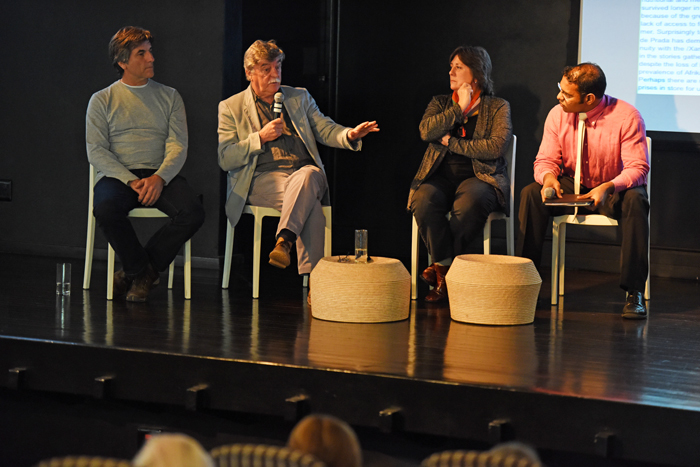Creative vehicles for serious science
01 October 2015 | Story by Newsroom
UCT lecturer and particle physicist Dr Sahal Yacoob probably never imagined science would put him on stage in shiny shoes – or have him counting lollipops as a proxy for popularity.
But as an academic interested in growing young minds, Yacoob has a good sense of what it takes to get the public interested in what science has to say about the world, why it's an important two-way conversation – and how it can be imaginative and involve creative collaborations with artists, musicians, illustrators and composers.
These elements were under lights at the 2nd SAYAS Symposium on Science and Society in Africa, a dense two-day programme on 28 and 29 September at which Yacoob was a moderator.
The theme was 'Fact, Fiction and Media: Re-imagining science engagement and its impact'. Panelists included academics and professionals in astrophysics, archaeology, urban design, editing, writing, curating, history, music, design, and public health.
The symposium was organised by the South African Young Academy of Science (SAYAS): 50 of South Africa's top young post-PhD scientists (if you're under 40 you're considered young).
Established in 2011, SAYAS is the “voice of young scientists” and the brainchild of the Department of Science and Technology.
At the helm of the symposium was SAYAS co-chair and senior lecturer in the School of Public Health and Family Medicine Dr Tolu Oni, a Next Einstein Forum Fellow. She said she hoped young people would be inspired and encouraged to pursue science. “We also hope to show the potential for science to address societal challenges.”
Up for discussion were interdisciplinarity, stereotypes, the challenges of the education system, and meaningful engagement between scientists and society.
One example of this interdisciplinary collaboration was reflected in the first session between SKA SARChi Chair Professor Roy Maartens (University of the Western Cape), and the curators of the Square Kilometre Array 'indigenous astronomy' exhibition, Shared Sky, at the National Art Gallery in the form of Emeritus Professor John Parkington (UCT) and Sandra Proselandis.
The artistic works on display reflected how aboriginal people understood the cosmos, weaving this thinking into their folklore, narratives and creative expressions. A similar exhibition went on display in Australia, which is a SKA co-host.
Sci-fi novelists Lauren Beukes and Nnedi Okorafor from Nigeria, a professor in creative writing, were in conversation with Oni on parallels between science and science fiction. The conversation exposed the importance of narrative in capturing public imagination and of challenging norms, including experiences of gender imbalances in science and science fiction writing, and misperceptions of the role of science and science fiction in Africa.
Among the participants were Grade 9 and 10 scholars from Khayelitsha's Centre of Science and Technology (COSAT) who belong to the Optimistic Youth Reporters from the Children's Radio Foundation. They put science questions to a panel of researchers (and rated their answers with a count of lollipops) and then played back recordings of how their COSAT peers had answered the same questions.
In her summary Oni said there were many examples of “academic hybrids”, those who did not perpetuate the academic stereotype as scholars working in silos, divorced from the needs of society.
“It's important not to perpetuate academic stereotypes if we are to change the narrative for the next generation. We have the next generation here. We do want to get our science out there. We are the academy. I challenge us to harness the narrative and direction we would like.”
Story by Helen Swingler. Image by Michael Hammond.
 This work is licensed under a Creative Commons Attribution-NoDerivatives 4.0 International License.
This work is licensed under a Creative Commons Attribution-NoDerivatives 4.0 International License.
Please view the republishing articles page for more information.










